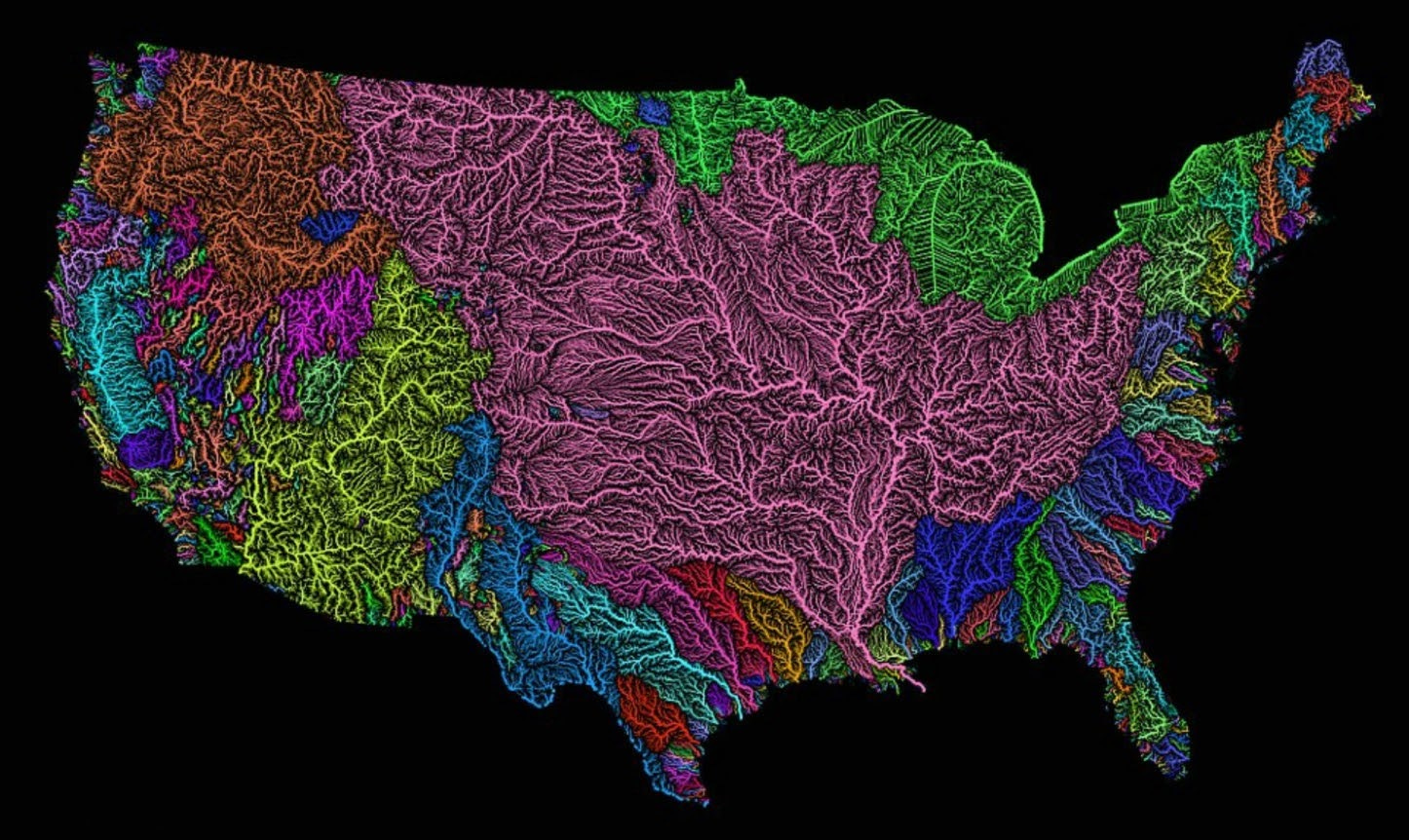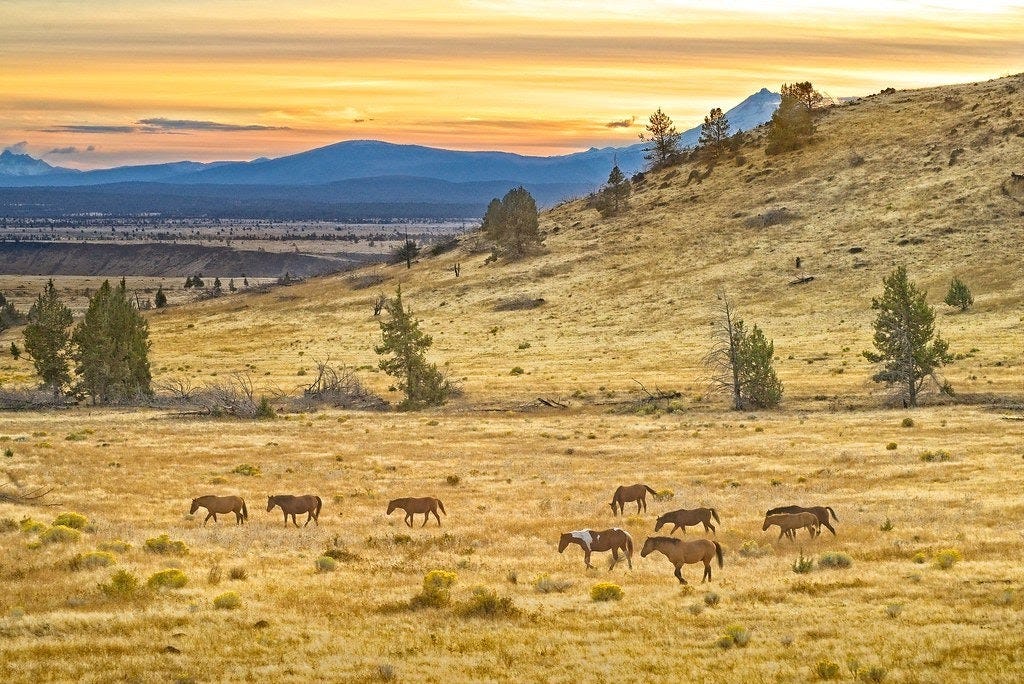Christina deVillier: A Watershed Moment for Representation
We need a paradigm shift. We need a better map: a more holistic framework within which to evaluate our identities, values, & priorities. Deb Haaland as Secretary of the Interior may give us a glimpse.
Housekeeping
Will you complete our readership survey? Let us know how we can continue our work to bring Oregonians together. Take the short survey here.
Be sure to tune in tomorrow for Part II from Sarah White and Hilary Dumitrescu!
Finally, if you get a chance to share your favorite Oregon Way post from 2020 on social media, that would be much appreciated!
To the post!
Christina deVillier is a writer, a gardener, and a fourth-generation explorer of northeast Oregon's mountains, canyons, and communities.
During the last couple of election cycles, I’ve come across a number of different data visualizations that purport to more accurately map the American electoral landscape than those that depict simple wins by county or state. Take, for example, the map below by data scientist Karim Douïeb, which morphs a “traditional” electoral map of the U.S.—a sea of red with a few blue islands—to an alternative visualization that shows red or blue wins by relative population. The urban counties balloon, reflecting population density; rural counties shrink to pinpricks on a blank white slate. The caption of this map, and others like it, is usually something along the lines of: “Land doesn’t vote. People do.”
While I’m a great believer in one-person-one-vote bottom-up democracy, and appreciate what maps like this are trying to show, that caption has always rubbed me the wrong way. It’s too dismissive of land.
I suppose that on some level I feel that the land ought to have a vote, somehow: a right to representation. At the very least, I wish we were better, as a nation, at understanding our politics, and envisioning our futures, in relation to the lands, waters, and ecologies that enfold us and upon which we utterly depend. Imagine a map that showed voting behavior by watershed, say. How might such a reorientation change our understanding of who we are, what we value, what we need?

After all, America’s land—stolen, stretched, tended, overburdened, “privately owned” or “held in trust,” fertile and poisoned and blown away and various and beautiful—is the literal foundation of our fraught democracy.
This desire of mine to see the land itself better represented, and better understood, in our politics is one of the reasons I am over-the-moon thrilled that the Biden team has tapped U.S. Representative Deb Haaland (D-NM), a “35th generation New Mexican” and a tribal citizen of Laguna Pueblo, to lead the U.S. Department of the Interior (DOI).
If confirmed, Rep. Haaland, who is already one of the first two Native women ever elected to Congress, will be America’s first Indigenous cabinet member, taking charge of the department that, in the words of one Chickasaw policy expert, “manages the physical manifestation of America.”
The DOI administers 500 million acres of U.S. public lands, or one-fifth of all land in the country, including 61 million acres in Oregon; manages the nation’s natural resources (including much of its water, via the Bureau of Reclamation); and handles most government-to-government relationships with federally recognized Tribes, including consultation on all activities affecting “Tribal cultural practices, lands, resources, or access to traditional areas of cultural or religious importance on federally managed lands.”
These two arenas of government activity—Tribal relations and federal land management—are inextricably intertwined. It’s impossible even to begin to understand the U.S. relationship with Indigenous people without unpacking the U.S. relationship to land—and vice versa. The history is complicated and painful.
All lands in the U.S. were stolen (over and over again, under various pretexts and mechanisms) from Tribes. Today, Indigenous communities still suffer the consequences of this theft of resources and identity, and nevertheless still maintain powerful physical, spiritual, and legal relationships with (and rights to) cultural sites and travel routes, artifacts, foods and medicines, kinship networks, and traditional practices across their ancestral homelands.

In the imperialist paradigm, land is a “resource” to be divided and conquered, fenced off or made to serve a profit motive. Indigenous peoples, in contrast, maintain epistemologies that recognize their communities’ embeddedness within networks of relationships with lands, waters, others, and kin.
As Julian Brave Noisecat, a Salish native of the Pacific Northwest, puts it: “While Indigenous values, beliefs and practices are as diverse as Indigenous people themselves, they find common roots in a relationship to land and water radically different from the notion of property. For Indigenous people, land and water are regarded as sacred, living relatives, ancestors, places of origin or any combination of the above… [T]he people are of the land and the land is of the people. These kindred spirits are alive and inseparable.”
There’s no “going back” to a pre-colonized United States. But there are paths forward that better align with our ecological foundations—and limitations. So it’s appropriate, to my mind, that all over the country and the world, Indigenous folks, with worldviews built on relationality, are stepping up to lead.
Rep. Haaland is a pragmatic, bipartisan, forward-thinking policymaker grounded firmly in a cultural value system that upholds her Pueblo community’s strong and reciprocal relationship with land. All over Indian Country, people have organized on her behalf, pushing hard for first her election and now her nomination to lead the DOI.
With the nomination in hand, these communities are celebrating now, knowing that Tribal consultation, with Haaland at the helm, will be much more than a hoop to jump through. Environmentalists and progressives of all stripes, who know and respect Rep. Haaland’s record in the U.S. House and as the former Chair of the Democratic Party of New Mexico, are celebrating too.
As one member of a small (yet politically diverse) caucus of Native lawmakers in Congress, Rep. Haaland recognizes the need to represent a holistic Indigenous environmental ethic in the rooms where big decisions are made. Before being elected to the House, she was instrumental in bringing Indigenous leaders and lawmakers together to craft New Mexico’s bold climate policy.
As a Congresswoman, Rep. Haaland has continued that focus; since her term in the U.S. House of Representatives began, she’s vice-chaired the House Natural Resources Subcommittee, forged consensus across the aisle, and sponsored dozens of bills on environmental and Tribal issues, including resisting fossil fuel development on public lands in New Mexico and elsewhere. As she says: the Southwest is “my homeland. It is proper for me to want to protect it.” Haaland leads the 30x30 initiative in the House: an ambitious proposal to conserve 30% of U.S. lands and waters by 2030.
From a representation perspective, it’s momentous that a Native woman has been tapped to oversee the department that once vowed to “civilize or exterminate” Indigenous people in the United States. And from a lands-and-waters perspective, there’s a lot of damage to undo: over the last four years, Trump’s DOI has sanctioned the ransacking of public lands, bulldozed sacred sites while sidestepping its obligation to consult with Tribes, silenced scientists, and rolled back environmental protections across the board.
Of course, all these recent outrages sit on top of the existential threats of accelerating climate change and biodiversity loss, which won’t be solved with technical thought experiments, thumb twiddling, or tweaks to the status quo. We need a paradigm shift. We need a better map: a more holistic framework within which to evaluate our identities, values, and priorities.

And I feel we may be glimpsing one. An appointment like this is a big step in the right direction. For the past several decades, with slow quiet work and bright art work and flash points like Standing Rock, Indigenous peoples worldwide have been leading and claiming a renaissance of culture and sovereignty: a development that I believe may help all of us to reimagine and remember our accountability to our home places and home planet.
In my own work in conservation, learning and relearning, in partnership, how to uphold and empower Indigenous caretaking of land is fundamental. I’m working in this arena—tending this learning—in part because these relationships are, for me, a source of environmental “slow hope,” the first I’ve found in my adult life: here in my home, and everywhere in the world, there are cultures who remember how to be in right relationship, long-term, with their specific lands and waters.
And, worldwide, the proof is in the pudding: 80% of biodiversity surviving on earth today is stewarded by Indigenous peoples. Upholding Indigenous sovereignty is upholding a land ethic with deep, deep roots: 16,000+ years in my neck of the woods. Time immemorial.
Representation (whether land on a map, or identity in the halls of power) is just a first step, and no one person, even one as passionate and grounded as Rep. Deb Haaland, can or should be expected to turn a ship around, especially one as big and hasty and full of contradiction as the American experiment.
Nevertheless, when I got the news of her nomination, I felt a deep thrill of anticipation, an inkling of a possibility of a true change in direction. This moment, a culmination of a lot of work by a lot of thoughtful people, may be a watershed moment: an invitation to reimagine our laws, needs and stories—to get the land back onto the maps.
**************************************
Keep the conversation going:
Facebook (facebook.com/oregonway)
Twitter (@the_oregon_way)
Check out our podcast:
#99




